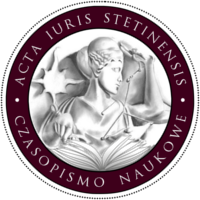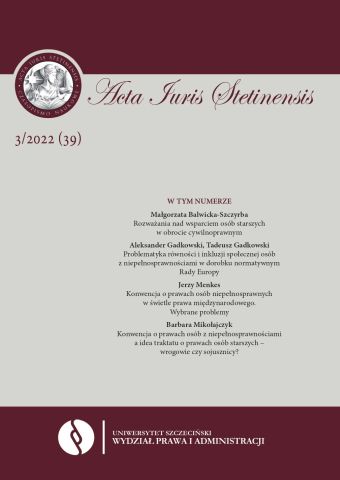







| Authors: |
Jerzy
Menkes

Szkoła Główna Handlowa w Warszawie |
| Keywords: | Convention on the Rights of Persons with disabilities CRPD persons with disabilities human rights discrimination equality protection from discrimination |
| Data publikacji całości: | 2022 |
| Page range: | 27 (89-115) |
| Downloads ?: | 182 |
| 1. | Anderson E.S., Integration, Affirmative Action, and Strict Scrutiny, „New York University Law Review” 2002, vol. 77, no. 5, www.nyulawreview.org/issues/volume-77-number-5/integration-affirmative-action-and-strict-scrutiny/. |
| 2. | Anderson T.H., The pursuit of fairness: a history of affirmative action, New York 2004, https://archive.org/details/pursuitoffairnes00ande/page/n9/mode/2up. |
| 3. | Benzenhöfer U., Euthanasia in Germany Before and During the Third Reich, Münster, Ulm 2010. |
| 4. | Desuetude, „Harvard Law Review” 2006, vol.119, no.7. |
| 5. | Ehrlich E., Fundamental Principles of the Sociology of Law, Massachusetts 1936, https://archive.org/details/in.ernet.dli.2015.217943. |
| 6. | Eugenics, Stanford Encyclopedia of Philosophy 2014 https://plato.stanford.edu/entries/eugenics. |
| 7. | Goffam E., Stigma: Notes on the Management of Spoiled Identity, „Touchstone Press” 1986, Chapter One. |
| 8. | Góralski W., Przesłanki małżeństwa w prawie polskim i w prawie kanonicznym, „Ius Matrimoniale” 2006, nr 11(17). |
| 9. | Götz A., Obciążeni. “Eutanazja” w nazistowskich Niemczech, Sękowa 2015. |
| 10. | Holmes Jr. O.W., The Path of Law, „Harvard Law Review” 1897, http://moglen.law.columbia.edu/LCS/palaw.pdf. |
| 11. | Jóźwiak M., Niepełnosprawność. Przeszkoda do kapłaństwa?, https://misyjne.pl/niepelnosprawnosc-przeszkoda-na-drodze-do-kaplanstwa. |
| 12. | Kanter A.S., Let’s Try Again: Why the United States Should Ratify the United Nations Convention on the Rights of People with Disabilities, „Touro Law Rewiev” 2019, vol.35. |
| 13. | Kelsen H., Czysta teorja prawa. Metoda i podejście zasadnicze), Warszawa 1934. |
| 14. | Kelsen H., Czym jest sprawiedliwość, Gdańsk 1996. |
| 15. | Kerbrat Y., Hennebel L., Aspects de droit international général dans la pratique des comités institués par les Nations Unies dans le domaine des droits de l’homme, „Annuaire Français de Droit International” 2012, vol.58. |
| 16. | Keynote speech, Disability Rights: From Charity to Equality, Meting, Dublin 1–3 June 2011, https://rm.coe.int/16806da803. |
| 17. | Klimczak A., Hipoteza Sapira-Whorfa – przegląd argumentów zwolenników i przeciwników, „Kultura-Społeczeństwo-Edukacja” 2018, nr 1(3). |
| 18. | Kyl J., Feith D.J., Fonte J., The War of Law. How New International Law Undermines Democratic Sovereignty, „Foreign Affairs” July/August 2013. |
| 19. | La distinction entre textes internationaux de portée juridique et textes internationaux dépourvus de portée juridique (à l’exception des textes émanant des organisations internationales), „Institute de Droit International. Annuaire” vol. 60, Part I–II, Session de Cambridge 1983. |
| 20. | Lombroso C., L’homme criminel: criminel-né, fou moral, épileptique: étude anthropologique et médico-légale, Paris 1887, https://polona.pl/item/l-homme-criminel-criminel--ne-fou-moral-epileptique-etude-anthropologique-et,MTgyMzQ1Nzg/6/#info:metadata. |
| 21. | Marach-Andruszkiewicz A., Prawo do święceń kapłańskich a problem niepełnosprawności kandydatów, „Kortowski Przegląd Prawniczy” 2013, nr 3. |
| 22. | Menkes J., Wasilkowski A., Organizacje międzynarodowe. Prawo instytucjonalne, Warszawa 2017. |
| 23. | Musielak M., Sterylizacja ludzi ze względów eugenicznych w Stanach Zjednoczonych, Niemczech i w Polsce (1899–1945), Poznań 2008. |
| 24. | Pastuszko M., Nieprawidłowości i przeszkody do święceń (kanony 1040–1049), „Prawo Kanoniczne: kwartalnik prawno-historyczny” 2007, nr 50/3–4. |
| 25. | Peretiakiewicz A., Teoria prawa i państwa H. Kelsena, „Ruch Prawniczy, Ekonomiczny i Socjologiczny” 1937, z. 4, https://repozytorium.amu.edu.pl/bitstream/10593/20256/1/012%20DR%20ANTONI%20PERETIATKOWICZ%20%20RPEiS%2017%284%29%2C%201937.pdf. |
| 26. | Pitkin H.F., Are Freedom and Liberty Twins?, „Political Theory” 1988, vol.16, no.4. |
| 27. | Płatek M., Dwa razy Lombroso, czyli o skutkach różnic w podejściu kryminologii pozytywistycznej i kryminologii feministycznej, „Archiwum Kryminologii” 2014, t.XXXVI. |
| 28. | Rapport initial soumis par la France en application de l’article 35 de la Convention, attendu en 2012. CRPD/C/FR A/1. |
| 29. | Series L., Disability and Human Rights, w: N. Watson, S. Vehmas (red.), Routledge Handbook of Disability Studies, London–New York 2020. |
| 30. | Świgost M., Dąbrowska A., Właściwości stygmatu a sytuacja życiowa człowieka zagrożonego stygmatyzacją, „Studia Edukacyjne” 2017. |
| 31. | Tokes C., Lawson B.E., Smitherman C., The Language of Affirmative Action: History, Public Policy, and Liberalism, „The Black Scholars. Journal of Black Studies and Research” 2003, Vol.33, Issue 3–4. |
| 32. | United Nations Office of the High Commissioner for Human Rights and the Inter-Parliamentary Union, From Exclusion to Equality: Realizing the Rights of Persons with Disabilities, Handbook for Parliamentarians on the Convention on the Rights of Persons with Disabilities and its Optional Protocol, Geneva, United Nations 2007. |
| 33. | White J.V., What is Affirmative Action?, „Scholarly Work” 2004, nr 306, https://scholars.law.unlv.edu/cgi/viewcontent.cgi?article=1302&context=facpub. |
| 34. | Zaremba M., Higieniści. Z dziejów eugeniki, Sękowa 2011. |
| 35. | Зотова Н., „Инвалиды” – правильное слово? Как говорить, чтобы не обидеть, BBC News, 27 сентября 2018, www.bbc.com/russian/news-45667220. |